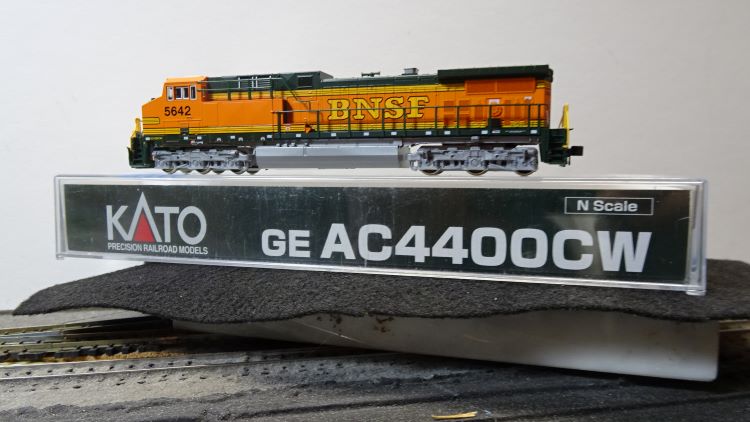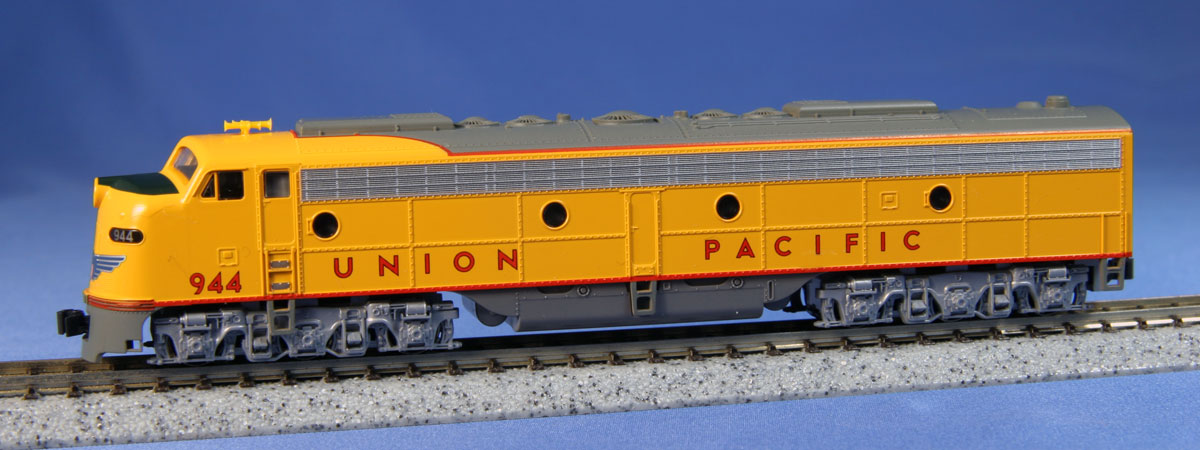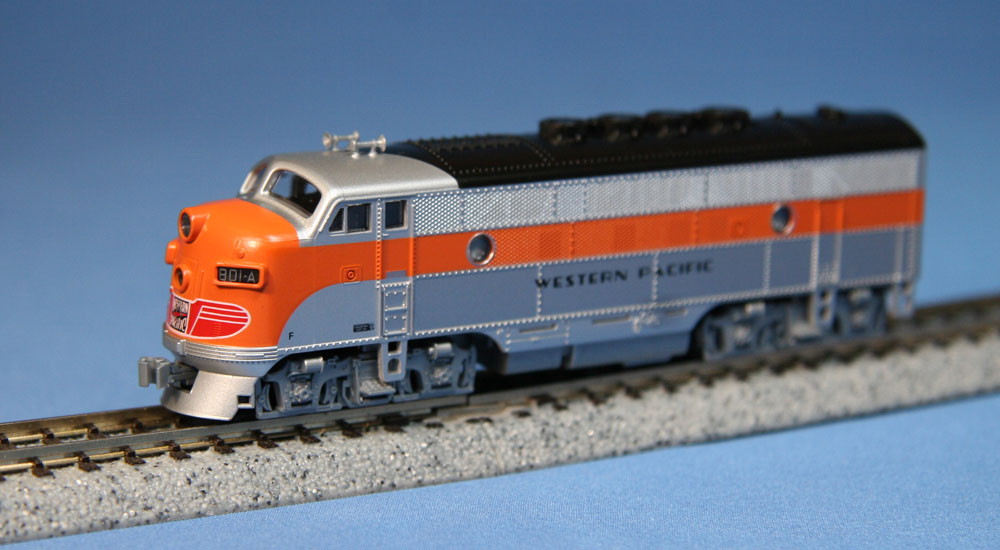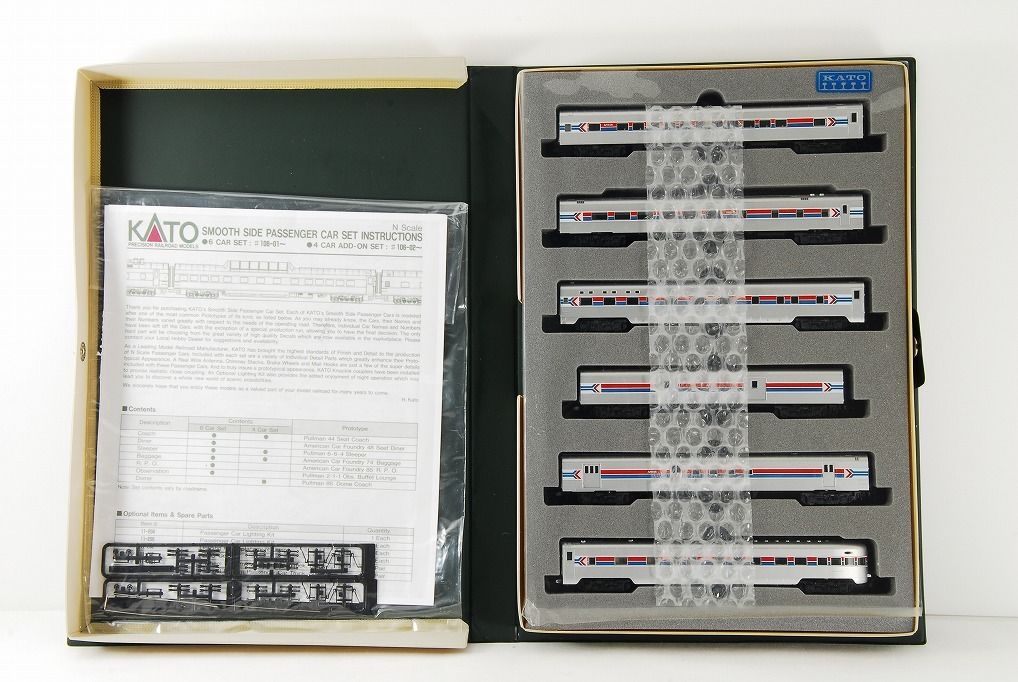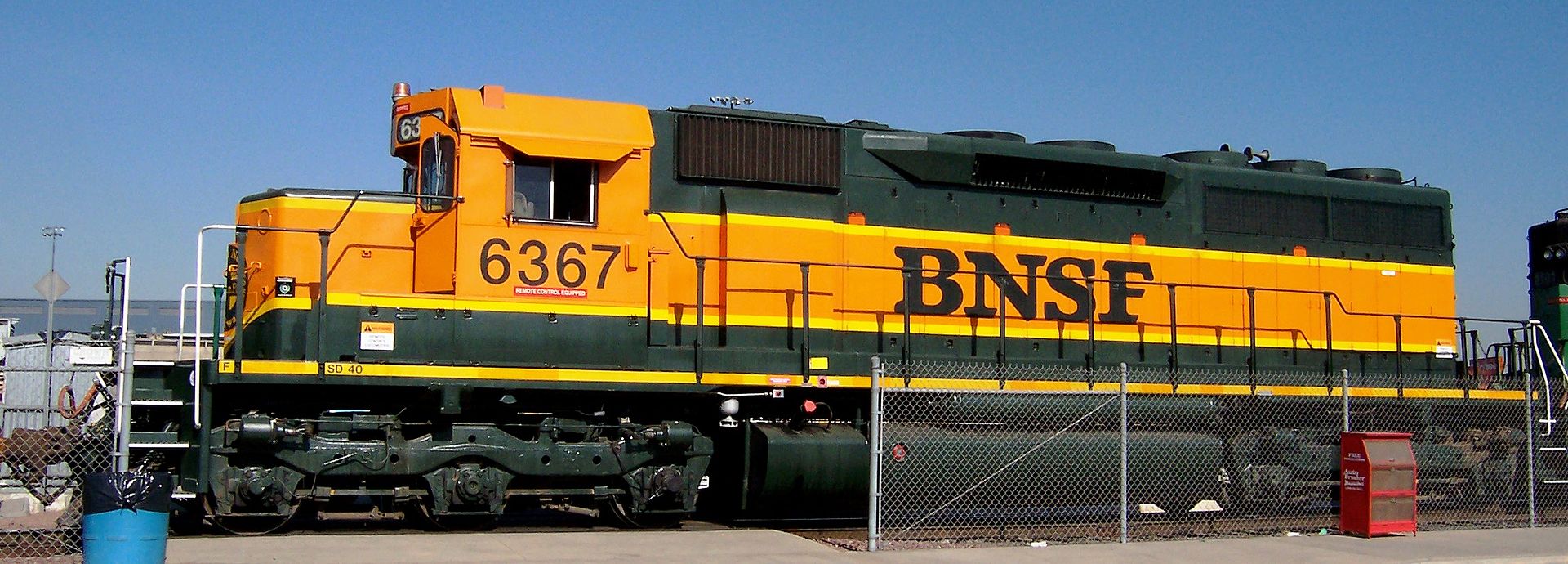Model Information: Kato introduced this '2nd generation" SD40 model in 1991. Later, in 1995, they started producing SD45s with the same mechanism. In 2002 they revised an re-released the SD40. In 2010 revised and re-released the SD45.
When it first came out, the Kato 1991 SD40 was considered very innovative for its time. The model features full pilots with body-mounted couplers. These models (both pre and post revision) run very well with excellent all-wheel pickup and drive. They are quiet and smooth running (though quite fast compared to new Atlas slow-speed mechanisms). They can really pull and handle fairly well on sharp curves. The key difference between the early and later version of the mechanism is the DCC support.
When it first came out, the Kato 1991 SD40 was considered very innovative for its time. The model features full pilots with body-mounted couplers. These models (both pre and post revision) run very well with excellent all-wheel pickup and drive. They are quiet and smooth running (though quite fast compared to new Atlas slow-speed mechanisms). They can really pull and handle fairly well on sharp curves. The key difference between the early and later version of the mechanism is the DCC support.
DCC Information: The early versions (pre-2002) are considered DCC-friendly. The later revisions support drop-in decoders. I suspect that it is easier and cheaper to take one of the old shells and drop it over a new chassis than to try to convert an old mechanism to DCC.
Prototype History: The EMD SD40 is a 6-axle road switcher diesel-electric locomotive built by General Motors Electro-Motive Division between January 1966 and August 1972. In 1966, EMD updated its locomotive catalog with entirely new models, all powered by the new 645 diesel engine. These included six-axle models SD38, SD40, SDP40 and SD45. All shared standardized components, including the frame, cab, generator, trucks, traction motors, and air brakes. The primary difference was the power output, with SD40 being rated at 3,000 hp (2,240 kW) from a turbocharged V16.
856 examples of this locomotive model were built for American railroads, 330 were built for Canadian railroads, 72 were built for Mexican railroads, 6 were built for the Guinea-Boke Project, and 4 SD40Ms riding on 5 ft 3 in (1,600 mm) gauge trucks were exported to Brazil.
From Wikipedia
Read more on American-Rails.com
Full SD40 data sheet on The Diesel Shop.
856 examples of this locomotive model were built for American railroads, 330 were built for Canadian railroads, 72 were built for Mexican railroads, 6 were built for the Guinea-Boke Project, and 4 SD40Ms riding on 5 ft 3 in (1,600 mm) gauge trucks were exported to Brazil.
From Wikipedia
Read more on American-Rails.com
Full SD40 data sheet on The Diesel Shop.
Road Name History:  The Burlington Northern Railroad (reporting mark BN) was a United States railroad. It was a product of a March 2, 1970, merger of four major railroads - the Great Northern Railway, Northern Pacific Railway, Spokane, Portland and Seattle Railway and the Chicago, Burlington and Quincy Railroad - as well as a few small jointly owned subsidiaries owned by the four.
The Burlington Northern Railroad (reporting mark BN) was a United States railroad. It was a product of a March 2, 1970, merger of four major railroads - the Great Northern Railway, Northern Pacific Railway, Spokane, Portland and Seattle Railway and the Chicago, Burlington and Quincy Railroad - as well as a few small jointly owned subsidiaries owned by the four.
Burlington Northern operated between 1970 and 1996.
Its historical lineage begins in the earliest days of railroading with the chartering in 1848 of the Chicago and Aurora Railroad, a direct ancestor line of the Chicago, Burlington and Quincy Railroad, which lends Burlington to the names of various merger-produced successors.
Burlington Northern purchased the Atchison, Topeka and Santa Fe Railway on December 31, 1996 to form the Burlington Northern and Santa Fe Railway (later renamed BNSF Railway), which was owned by the Burlington Northern Santa Fe Corporation.*
Read more on Wikipedia.

Burlington Northern operated between 1970 and 1996.
Its historical lineage begins in the earliest days of railroading with the chartering in 1848 of the Chicago and Aurora Railroad, a direct ancestor line of the Chicago, Burlington and Quincy Railroad, which lends Burlington to the names of various merger-produced successors.
Burlington Northern purchased the Atchison, Topeka and Santa Fe Railway on December 31, 1996 to form the Burlington Northern and Santa Fe Railway (later renamed BNSF Railway), which was owned by the Burlington Northern Santa Fe Corporation.*
Read more on Wikipedia.
Brand/Importer Information: KATO U.S.A. was established in 1986, with the first U.S. locomotive model (the GP38-2, in N-Scale) released in 1987. Since that time, KATO has come to be known as one of the leading manufacturers of precision railroad products for the modeling community. KATO's parent company, Sekisui Kinzoku Co., Ltd., is headquartered in Tokyo, Japan.
In addition to producing ready-to-run HO and N scale models that are universally hailed for their high level of detail, craftsmanship and operation, KATO also manufactures UNITRACK. UNITRACK is the finest rail & roadbed modular track system available to modelers today. With the track and roadbed integrated into a single piece, UNITRACK features a nickel-silver rail and a realistic-looking roadbed. Patented UNIJOINERS allow sections to be snapped together quickly and securely, time after time if necessary.
The Kato U.S.A. office and warehouse facility is located in Schaumburg, Illinois, approximately 30 miles northwest of Chicago. All research & development of new North American products is performed here, in addition to the sales and distribution of merchandise to a vast network of wholesale representatives and retail dealers. Models requiring service sent in by hobbyists are usually attended to at this location as well. The manufacturing of all KATO products is performed in Japan.
Supporters of KATO should note that there is currently no showroom or operating exhibit of models at the Schaumburg facility. Furthermore, model parts are the only merchandise sold directly to consumers. (Please view the Parts Catalog of this website for more specific information.)
In addition to producing ready-to-run HO and N scale models that are universally hailed for their high level of detail, craftsmanship and operation, KATO also manufactures UNITRACK. UNITRACK is the finest rail & roadbed modular track system available to modelers today. With the track and roadbed integrated into a single piece, UNITRACK features a nickel-silver rail and a realistic-looking roadbed. Patented UNIJOINERS allow sections to be snapped together quickly and securely, time after time if necessary.
The Kato U.S.A. office and warehouse facility is located in Schaumburg, Illinois, approximately 30 miles northwest of Chicago. All research & development of new North American products is performed here, in addition to the sales and distribution of merchandise to a vast network of wholesale representatives and retail dealers. Models requiring service sent in by hobbyists are usually attended to at this location as well. The manufacturing of all KATO products is performed in Japan.
Supporters of KATO should note that there is currently no showroom or operating exhibit of models at the Schaumburg facility. Furthermore, model parts are the only merchandise sold directly to consumers. (Please view the Parts Catalog of this website for more specific information.)
Item created by: gdm on 2017-01-06 07:22:26. Last edited by Lethe on 2020-05-18 12:19:40
If you see errors or missing data in this entry, please feel free to log in and edit it. Anyone with a Gmail account can log in instantly.
If you see errors or missing data in this entry, please feel free to log in and edit it. Anyone with a Gmail account can log in instantly.





